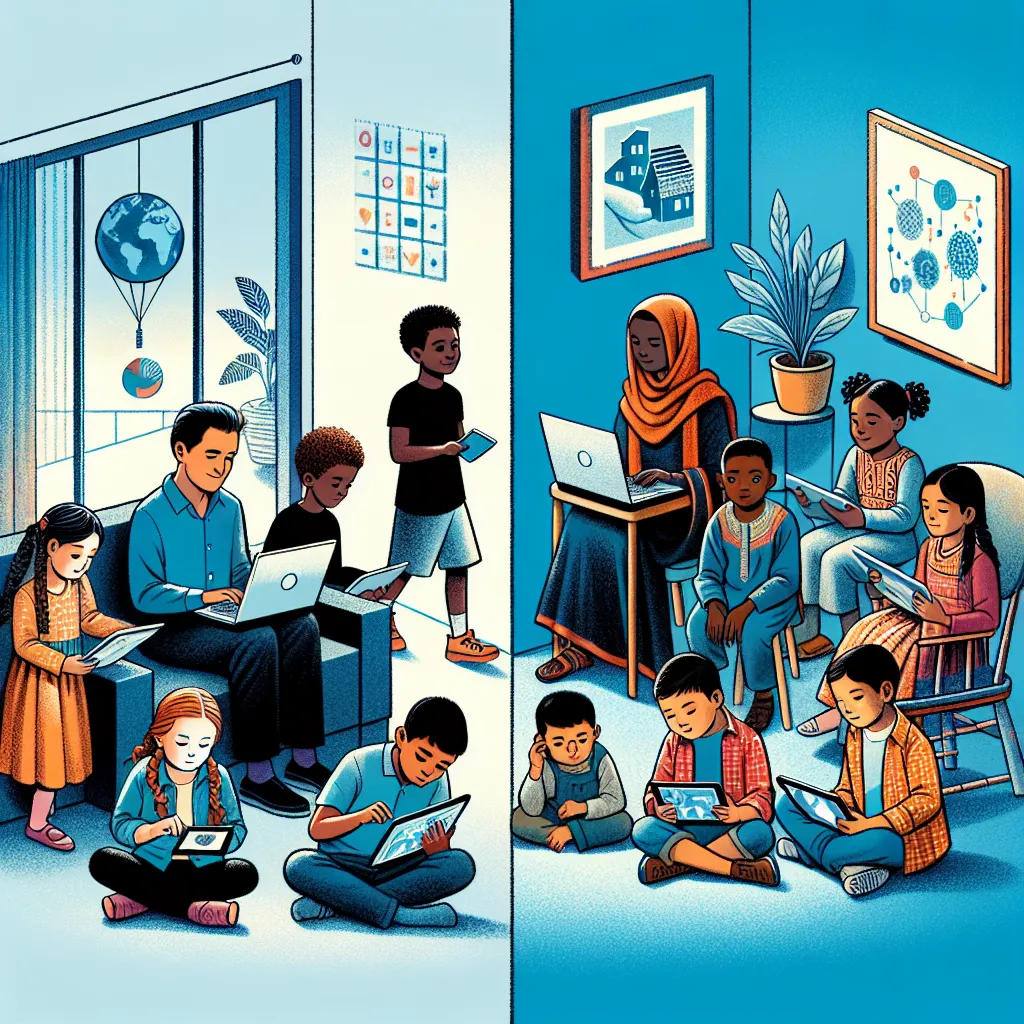In recent years, the topic of technology’s role in education has gained significant prominence in IELTS Writing Task 2. This essay question explores how technological advancements can help reduce educational inequalities, a subject that has become increasingly relevant in our digital age. Based on past exam trends and the growing importance of this issue, we can expect to see more questions related to this theme in future IELTS tests.
Let’s examine a typical IELTS Writing Task 2 question on this topic:
Some people believe that technology has the potential to bridge educational gaps between different socioeconomic groups. Others argue that it may widen the divide. Discuss both views and give your own opinion.
Analyzing the Question
This question requires candidates to:
- Discuss how technology can reduce educational inequalities
- Explain how technology might increase the educational divide
- Provide a personal opinion on the matter
It’s crucial to address all parts of the question to achieve a high band score.
Sample Essay 1 (Band 8-9)
In the digital age, technology’s role in education has become a topic of heated debate. While some argue that technological advancements can narrow the educational gap between different socioeconomic groups, others contend that it may exacerbate existing inequalities. This essay will examine both perspectives before presenting my own viewpoint.
Proponents of technology in education argue that it can democratize learning opportunities. Online platforms and educational apps provide access to high-quality resources that were once the privilege of the wealthy. For instance, Massive Open Online Courses (MOOCs) allow students from underprivileged backgrounds to access lectures from world-renowned universities. Moreover, adaptive learning software can personalize education, addressing individual learning needs more effectively than traditional one-size-fits-all approaches.
On the other hand, skeptics contend that technology might widen the educational divide. They argue that access to devices and reliable internet connections is not universal, creating a ‘digital divide’ that mirrors existing socioeconomic disparities. Furthermore, the effective use of educational technology often requires digital literacy skills that disadvantaged students may lack. This could potentially leave them further behind their more privileged peers who are better equipped to leverage these tools.
In my opinion, while the concerns about technological inequality are valid, the potential benefits of technology in bridging educational gaps outweigh the drawbacks. The key lies in implementing targeted policies to ensure equitable access to both hardware and the skills needed to use it effectively. Governments and educational institutions should invest in providing devices and internet access to underprivileged students, coupled with comprehensive digital literacy programs.
In conclusion, technology has the potential to be a powerful equalizer in education, but only if we actively work to ensure its benefits reach all segments of society. By addressing the challenges of access and digital literacy, we can harness technology’s potential to create a more level playing field in education.
(Word count: 309)
Sample Essay 2 (Band 6-7)
The role of technology in education is a controversial topic. Some people think it can help reduce educational inequalities, while others believe it might make them worse. This essay will discuss both views and give my opinion.
On one hand, technology can provide more learning opportunities for everyone. With the internet, students can access a lot of information and online courses for free or at low cost. This means that even students from poor families can learn from good teachers and use quality materials. For example, websites like Khan Academy offer free lessons on many subjects, which can help students who can’t afford expensive tuition.
However, there are also arguments against technology in education. Not everyone has a computer or good internet at home, especially in poor areas or developing countries. This means that some students might not be able to use these online resources, making the gap between rich and poor students even bigger. Also, some students might not know how to use technology well, which can put them at a disadvantage.
In my opinion, technology can be very helpful in reducing educational inequalities, but only if it is used carefully. Governments and schools should make sure that all students have access to computers and the internet. They should also teach students how to use technology effectively for learning. This way, everyone can benefit from educational technology, not just those who are already privileged.
To conclude, while there are challenges in using technology to bridge educational gaps, I believe its potential benefits are greater than its drawbacks. With the right policies and support, technology can help create more equal educational opportunities for all students, regardless of their background.
(Word count: 276)
 digital divide
digital divide
Key Points to Remember When Writing
-
Structure: Both essays follow a clear structure with an introduction, body paragraphs discussing both views, the writer’s opinion, and a conclusion. This organization is crucial for achieving a high band score.
-
Vocabulary: The Band 8-9 essay uses more sophisticated vocabulary and phrases like “democratize learning opportunities,” “exacerbate existing inequalities,” and “level playing field.” The Band 6-7 essay uses simpler language but still effectively communicates the ideas.
-
Grammar: The higher band essay demonstrates a wider range of grammatical structures, including complex sentences and passive voice. The Band 6-7 essay uses simpler structures but maintains grammatical accuracy.
-
Cohesion and Coherence: Both essays use appropriate linking words and phrases to connect ideas, but the Band 8-9 essay does so more skillfully and with greater variety.
-
Task Response: Both essays address all parts of the question, but the Band 8-9 essay provides more detailed examples and a more nuanced opinion.
Vocabulary to Remember
- Democratize (verb) /dɪˈmɒkrətaɪz/: To make something available to all people
- Exacerbate (verb) /ɪɡˈzæsəbeɪt/: To make a problem or bad situation worse
- Disparity (noun) /dɪˈspærəti/: A great difference between things
- Digital literacy (noun) /ˈdɪdʒɪtl ˈlɪtərəsi/: The ability to use digital technology effectively
- Equitable (adjective) /ˈekwɪtəbl/: Fair and impartial
- Leverage (verb) /ˈliːvərɪdʒ/: Use something to maximum advantage
- Underprivileged (adjective) /ˌʌndəˈprɪvəlɪdʒd/: Not enjoying the same standard of living or rights as the majority of people in a society
- Adaptive learning (noun) /əˈdæptɪv ˈlɜːnɪŋ/: An educational method which uses computer algorithms to orchestrate the interaction with the learner
Conclusion
The role of technology in bridging educational gaps is a complex and relevant topic for IELTS Writing Task 2. To excel in writing about this subject, it’s essential to consider multiple perspectives, provide concrete examples, and offer a balanced opinion. Remember to practice writing essays on related topics, such as the impact of online learning on educational inequality or the influence of digital platforms on global communication.
For further practice, try writing an essay on the following question: “Some people argue that technology in classrooms is a distraction, while others believe it enhances learning. Discuss both views and give your opinion.” Feel free to share your essay in the comments section for feedback and discussion. This active practice will significantly improve your IELTS writing skills.


